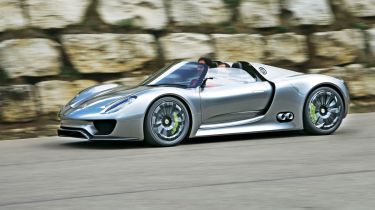Porsche 918 Hybrid
We sample the world’s greenest, meanest, most eagerly awaited supercar!
IT’S great news a heavyweight such as Porsche has taken on the challenge of building an eco supercar. Yet it won’t be easy. Combining 200mph performance with sub-100g/km CO2 emissions is unknown territory – although if anyone can pull it off, it’s the German brand. Our short ride confirmed that despite its sky-high price and limited availability, the finished product is certain to become the new performance car benchmark.
If you’re scared of spiders, look away now! Porsche stunned everyone when it introduced the hybrid 918 Spyder at the Geneva Motor Show earlier this year, but nobody has been able to experience the eco-friendly hypercar first hand... until now.
[[{"type":"media","view_mode":"content_narrow","fid":"69283","attributes":{"alt":"","class":"media-image"}}]]
We were invited by Porsche to take a world exclusive passenger ride in its latest concept, and jumped at the opportunity – as the 918 Spyder is more than just a jaw-dropping show car. Following overwhelming public reaction, bosses have given it
the green light for production.
Our drive didn’t get off to the most exciting start. Prioritising the car’s eco credentials, Porsche chose to show off the electric-only mode first. And while the range of 16 emissions-free miles is a very impressive trick for a performance car, from the passenger seat, it’s not the most spectacular experience.
Used - available now

2023 Land Rover
Range Rover Evoque
18,682 milesAutomaticDiesel2.0L
Cash £33,995
2019 BMW
1 Series
48,573 milesAutomaticPetrol1.5L
Cash £13,987
2017 Ford
Fiesta
38,600 milesManualPetrol1.2L
Cash £6,100
2016 Tesla
Model S
78,000 milesAutomaticElectric
Cash £18,999In fact, the whining sound from the electric motors is rather uninspiring.
Factor in the on-board petrol engine, however, and things start to get a whole lot more exciting. The mid-mounted 493bhp 3.4-litre V8 comes from the company’s Spyder race car, although the red line is dropped from 11,000rpm to 9,200rpm
to ensure better reliability.
Three electric motors – two on the front axle, one at the rear – add 215bhp, while power is fed to the wheels through a seven-speed PDK dual-clutch gearbox.
The results are astonishing.
With its total output of 718bhp and 1,490kg kerbweight – thanks largely to using the Carrera GT’s carbon tub – the car sprints from 0-62mph in 3.2 seconds and hits a 198mph top speed. Computer simulations have also calculated that it would be able to lap the Nürburgring in under seven-and-a-half minutes – faster than the V10-powered Carrera GT.
But the truly remarkable figures are the combined fuel economy of 94mpg and CO2 emissions of 70g/km. Four driving modes – E-Drive (electric), Hybrid, Sport and Race – help strike a balance between flat-out performance and maximum efficiency.
While we didn’t get the chance to verify these figures, our brief encounter was certainly thrilling. The V8 fires up with a deafening roar from the side-exit exhausts, and there’s a frightening surge of acceleration with every prod of the throttle. It could be up to four years before customers have the finished product on their driveways – engineers estimate the development cost for this car is 10 times higher than for the Carrera GT. However, a model with such monstrous pace and angelic emissions should be well worth the wait.
Rival: Merc. SLS E-Cell
THE all-electric Mercedes SLS, on sale in 2012, does without petrol power all together. But with 533bhp and a 0-62mph time of four seconds, it’s still every inch a genuine supercar.







